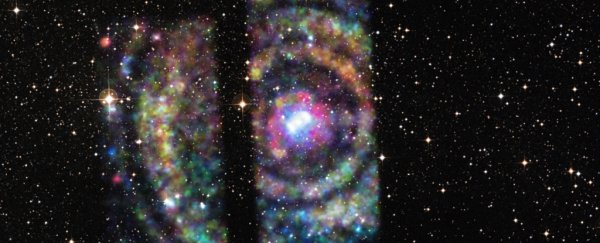New calculations from bored physicists have just brought us a bit closer to understanding how material can fall onto neutron stars to flare out powerful blasts of X-ray light.
If enough plasma is gravitationally attracted to the dead star from a binary companion, its mass is sufficient to force a way through the barrier created by the neutron star's powerful magnetic field, making its way to the neutron star atmosphere.
It's a significant part of the long-standing unsolved mystery of neutron star accretion and X-ray flares. The finding could help us to better understand the behavior of plasma in magnetic fields - something that could be applicable to the development of plasma fusion back here on Earth.
"This research started with abstract questions," said plasma physicist Russell Kulsrud of the Princeton Plasma Physics Laboratory.
"How can matter from a companion star break through a neutron star's powerful magnetic field to produce X-rays, and what causes the observed changes in those fields?"
Neutron stars are among the most dense objects in the Universe. They're what happens when a star of a certain mass (between 8 and 30 times the mass of the Sun) reaches the end of its main-sequence lifespan and dies.
The outer star material is blown off in a supernova explosion, while the core of the star gravitationally collapses, forming a compact, ultradense sphere that will, over millions of years, cease to shine - the only thing keeping it glowing is residual heat.
When we say dense, we mean dense, too. The only thing denser is a black hole (which, if the precursor star was any more massive than 30 solar masses, the core would have collapsed into). A neutron star is around 1.5 times the mass of the Sun, packed into something maybe 10 kilometers (6.2 miles) across.
These extreme objects hang out there in space, typically with a magnetic field trillions of times stronger than Earth's. Sometimes, they're accompanied by a binary companion, at a close-enough distance that the neutron star can capture and accrete material from the companion's atmosphere.
When this happens, the material forms a disc that feeds down onto the neutron star, gaining energy as it accelerates due to gravity. This energy escapes in the form of X-radiation, often concentrated in columns or hotspots at the neutron star's poles. We know this happens; we've observed it. But the question of how the plasma can pass through the magnetic field remained.
Luckily, Kulsrud had some time on his hands.
"When the pandemic started and everyone was confined to their homes, I decided to take up the model of a neutron star and work out a few things," he explained.
He and his colleague, astrophysicist Rashid Sunyaev of the Max Planck Institute for Astrophysics in Germany, conducted mathematical modeling to figure out whether the plasma anchors to and drags the magnetic field, or manages to slip through, leaving it intact.
According to their calculations, it's the latter. If the mass of the infalling plasma is high enough, it can exert gravitational pressure on the magnetic field. This produces a cascade of fluctuations in the strength of the magnetic field, resulting in an instability that allows the plasma to slip through.
Once the plasma is on the other side, it is funneled along the neutron star's magnetic field lines to the poles, where it accretes onto the neutron star.
According to this model, the plasma accumulating at the pole becomes too heavy to remain supported on the surface, and sinks into the neutron star interior. The additional interior pressure at the poles then distorts the magnetic field. Over time, the pressure causes the incoming plasma to spread over the entire surface of the neutron star, generating global X-radiation.
"The added mass on the neutron star's surface can distort the outer region of the star's magnetic field," Kulsrud said. "If you're observing the star, you should see that the radiation emitted by the magnetic field will gradually change. And in fact this is what we see."
The team notes that their speculations are unlikely to be apply to all neutron stars, because their treatment of the instability is approximate. However, the findings do predict the changing shape of the magnetic field over time, as well as an ultimate outcome.
Over the course of a few tens of thousands of years, the neutron star will gradually increase its mass, as well as its radius at a rate of around a millimeter per year, ultimately reaching a steady state for its magnetic field.
And the mathematics could have applications in the development of tokamak fusion reactors, which use magnetic fields to confine plasma.
"Though there aren't any direct applications of this research to the development of fusion energy, the physics is parallel," Kulsrud said.
"The diffusion of energy through tokamaks, doughnut-shaped fusion facilities used around the world, resembles the diffusion of matter across a neutron star's magnetic field."
The research has been published in the Journal of Plasma Physics.
